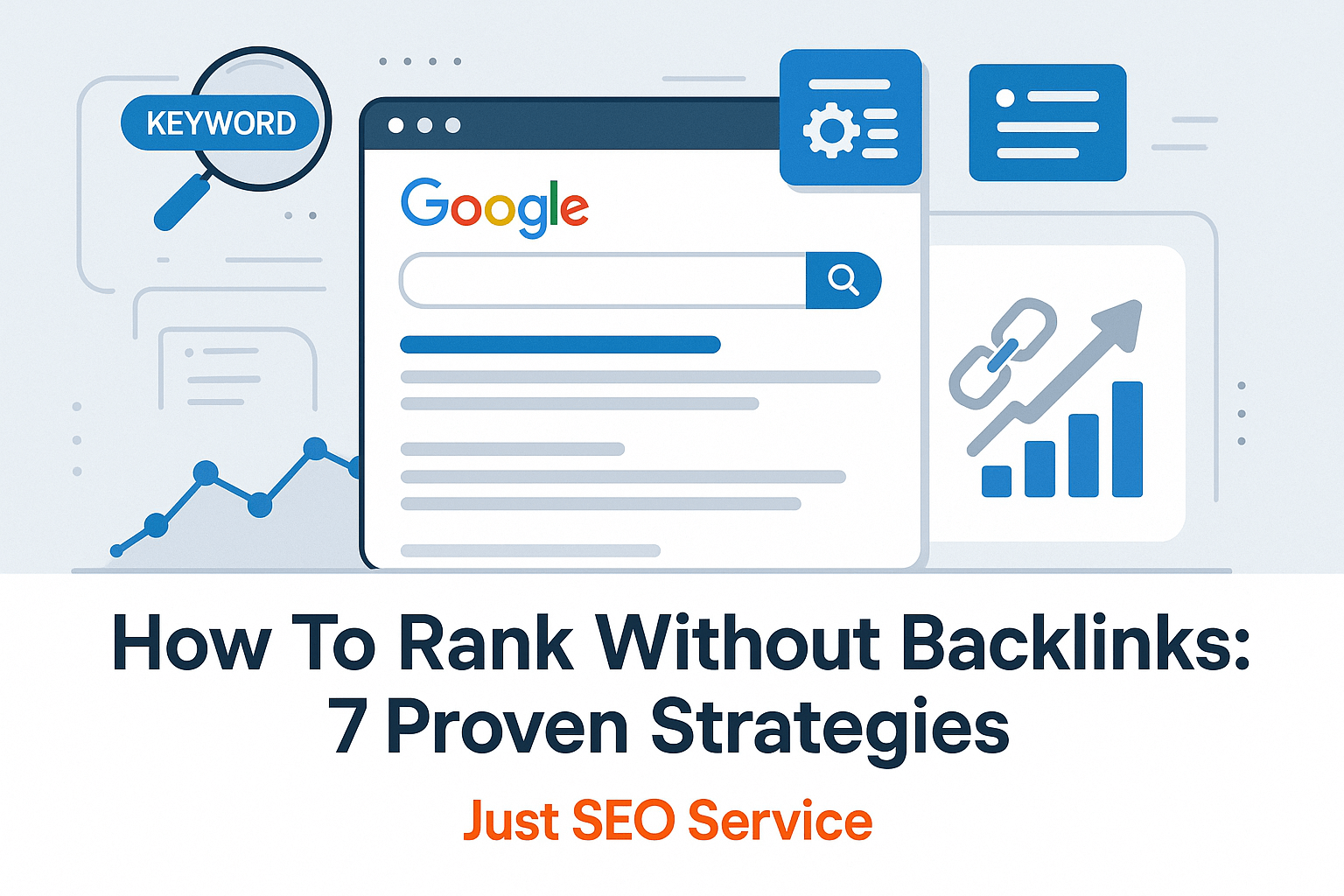How To Rank Without Backlinks: 7 Proven Strategies
Most SEO professionals will tell you that backlinks are essential for ranking success.
While high-quality backlinks certainly help, they’re not the only path to search engine visibility. Many websites achieve impressive rankings through strategic optimization techniques that don’t require a single external link.
This comprehensive guide reveals seven proven methods to boost your search rankings without relying on backlinks. These strategies focus on what you can control directly: your content, technical setup, and user experience. By implementing these techniques, you’ll build a solid foundation for organic growth that search engines reward.
1. Create High-Quality, Search-Optimized Content
Content remains the cornerstone of successful SEO campaigns. Search engines prioritize websites that provide genuine value to users through well-researched, comprehensive content that answers specific questions and solves real problems.
Focus on User Search Intent
Understanding what your audience actually wants to find is crucial. Start by analyzing the search results for your target keywords. Look at the top-ranking pages and identify patterns in their content structure, depth, and approach. This research reveals what search engines consider most relevant for those queries.
Create content that matches or exceeds the quality of existing top results. Go deeper into topics, provide fresh perspectives, and include practical examples that competitors miss. When your content becomes the most comprehensive resource on a topic, search engines take notice.
Optimize Content Structure
Well-structured content improves both user experience and search engine understanding. Use clear headings (H1, H2, H3) to organize your information logically. Include your target keywords naturally in headings and throughout the content, but avoid keyword stuffing.
Break up large text blocks with bullet points, numbered lists, and short paragraphs. This formatting makes content easier to scan and digest, leading to better user engagement metrics that search engines monitor.
2. Master Technical SEO Fundamentals
Technical SEO forms the foundation that allows search engines to properly crawl, index, and understand your website. Even the best content won’t rank well if technical issues prevent search engines from accessing it effectively.
Improve Site Speed and Performance
Page loading speed directly impacts both user experience and search rankings. Use tools like Google PageSpeed Insights to identify specific performance issues on your site. Common improvements include:
- Compressing images and using modern formats like WebP
- Minimizing CSS and JavaScript files
- Enabling browser caching
- Using a content delivery network (CDN)
- Optimizing server response times
Ensure Mobile Responsiveness
Mobile-first indexing means Google primarily uses your mobile site version for ranking purposes. Your website must provide an excellent experience across all device types. Test your site on various screen sizes and ensure all functionality works properly on mobile devices.
Create a Logical Site Structure
Organize your website with a clear hierarchy that makes sense to both users and search engines. Use descriptive URLs that include relevant keywords. Implement proper internal linking to help search engines understand the relationship between your pages and distribute page authority throughout your site.
3. Optimize On-Page SEO Elements
On-page optimization involves fine-tuning individual web pages to rank higher and earn more relevant traffic. These elements communicate directly with search engines about your content’s topic and relevance.
Craft Compelling Title Tags and Meta Descriptions
Your title tag is one of the most important on-page SEO factors. Include your primary keyword near the beginning while keeping titles under 60 characters to prevent truncation in search results. Write titles that accurately describe your content and entice users to click.
Meta descriptions don’t directly impact rankings but influence click-through rates. Write compelling descriptions under 160 characters that summarize your content’s value proposition and include relevant keywords naturally.
Use Header Tags Strategically
Header tags (H1, H2, H3) help search engines understand your content hierarchy. Use only one H1 tag per page, typically as your main headline. Incorporate related keywords in H2 and H3 tags while maintaining natural readability.
Optimize Images and Media
Every image on your site should include descriptive alt text that explains the image content. This helps search engines understand visual elements and improves accessibility. Use descriptive file names that include relevant keywords before uploading images.
4. Target Long-Tail Keywords
Long-tail keywords are longer, more specific phrases that typically have lower search volume but higher conversion potential. These keywords are easier to rank for without backlinks because they face less competition.
Research Untapped Keyword Opportunities
Use keyword research tools to identify long-tail variations of your main topics. Look for phrases with moderate search volume but lower competition scores. These represent opportunities where quality content can rank well without extensive link building.
Focus on keywords that reflect specific user problems or questions. For example, instead of targeting “SEO,” you might target “how to improve website rankings without backlinks” or “SEO strategies for new websites.”
Create Topic Clusters
Develop comprehensive content around related keyword groups. Create a main pillar page covering a broad topic, then support it with detailed pages addressing specific subtopics. This approach demonstrates topical authority and helps you capture traffic from multiple related searches.
5. Leverage Local SEO Opportunities
Local SEO presents excellent ranking opportunities for businesses serving specific geographic areas. Local search results often display with less competition than national keywords.
Optimize Google My Business
Claim and fully optimize your Google My Business listing. Include accurate business information, high-quality photos, and regular updates. Encourage satisfied customers to leave reviews, as positive reviews boost local search visibility.
Create Location-Specific Content
Develop content that addresses local needs and interests. Include location-specific keywords naturally in your content, titles, and meta descriptions. Create pages for different service areas if relevant to your business.
6. Focus on User Experience Signals
Search engines increasingly prioritize websites that provide excellent user experiences. These signals indicate whether users find your content valuable and engaging.
Improve Dwell Time and Engagement
Dwell time measures how long users stay on your page after clicking from search results. Longer dwell times suggest your content satisfies user intent. Improve dwell time by:
- Starting with compelling introductions that immediately address user needs
- Using engaging formatting with images, videos, and interactive elements
- Including internal links to related content that keeps users on your site
- Ending with clear calls-to-action or next steps
Reduce Bounce Rate
High bounce rates can signal that your content doesn’t match user expectations. Ensure your content delivers on the promise made in your title and meta description. Use clear navigation and logical content flow to guide users through your site.
7. Build Topical Authority
Topical authority means becoming recognized as an expert source on specific subjects. Search engines favor websites that demonstrate deep knowledge and expertise in particular areas.
Become the Go-To Resource
Create comprehensive, authoritative content that covers your chosen topics from every angle. Publish regularly on related subjects to demonstrate ongoing expertise. Update existing content with new information and insights to maintain relevance.
Showcase Expertise and Credentials
Include author bios that highlight relevant qualifications and experience. Display certifications, awards, or recognition that establish credibility. Link to authoritative sources and cite reputable studies to support your claims.
Transform Your SEO Strategy Today
Ranking without backlinks requires patience and consistent effort, but these strategies can deliver impressive results. Start by auditing your current website against these recommendations. Identify the areas where you can make the biggest improvements and create an action plan.
Focus on creating genuinely helpful content that serves your audience’s needs. Combine this with solid technical SEO and strategic keyword targeting to build sustainable organic growth. Remember that SEO success comes from providing value to users first – search engine rankings naturally follow.
Ready to boost your search rankings? Contact with Just SEO Service Team for a comprehensive SEO audit and personalized strategy recommendations tailored to your specific goals.

